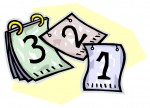Feabhra na bhFéilte ‘s na bhFeiseanna (February Holidays and Festivals) Posted by róislín on Jan 31, 2013 in Irish Language
(le Róislín)
These days we can find a special day to celebrate practically every item, product, or concept imaginable, from cheese-rolling (at Cooper’s Hill, England), wife-carrying (originally Finland, now international, including Newry, Maine, and locations in Wisconsin and Michigan), the Idiotarod [sic!] (various locations), and “Punch Your Neighbor Day” in Bolivia.
But for a mí ghearr, February seems especially full of fairly major holidays, festivals and special events. Let’s look first at some of the traditional ones, and then, just le haghaidh an chraic, we’ll look at some of the more obscure ones, obscure perhaps but always good for vocabulary development. Otherwise when would you get to practice words like “cnó piostáise” or “maróg Nollag“?
So, first, na cinn níos traidisiúnta. And, you guessed it, there are bearnaí to fill in below, just to ramp up the dúshlán ([DOO-hlawn], challenge). Even more ramped up than usual because in each case there are two forms given of the word to fill in. Only one is correct (at least in standard Irish), freagraí thíos:
Dáta Ainm i nGaeilge (Rogha A / B)
a) 1 Feabhra Lá Fhéile _____ (Bríd / Bríde)
b) 2 Feabhra Lá Fhéile __ na gCoinneal (Muire / Mhuire)
c) 12 Feabhra 2013 Máirt _____ (Inid / Inide)
d) 14 Feabhra Lá _______ Vailintín (Féile / Fhéile)
e) 18 Feabhra 2013 (SAM/USA) Lá na ______ (Uachtarán / nUachtarán)
Agus anois, na cinn níos áitiúla nó níos neamhchoitianta. Dála an scéil, none of these have traditional Irish names so I’ve translated them so we can have a fun vocab workout. Some of them are probably mostly gimicí margaíochta, ach cén dochar? In one case, the choice is between two completely different words, not two forms of the same word. The days designated “náisiúnta” (national) are observed primarily in America, not in Ireland.
f) 12 Feabhra Lá Maróg _______ (pluma / Nollag)
g) 15 Feabhra (SAM/USA) Lá Náisiúnta Meallán __ (guma / ghuma)
h) 23 Feabhra Lá “Imir ______” (leadóg / leadóige)
i) 26 Feabhra Lá Náisiúnta na gCnónna___ (Piostáise / bPiostáise)
j) 27 Feabhra Lá na _____ Bán (Béar / mBéar)
Tá súil agam gur bhain tú sult as sin. Tá na freagraí agus roinnt nótaí thíos. SGF, Róislín
Freagraí agus nótaí:
a) Lá Fhéile Bríde (B: genitive case ending), St. Bridget’s Day
b) Lá Fhéile Muire na gCoinneal (A: no lenition generally when saying things are “of” a saint), Candlemas, lit. The Feast Day of Mary of the Candles
c) Máirt Inide (B: genitive case ending) Shrove Tuesday, aka Mardi Gras aka Pancake Tuesday
d) Lá Fhéile Vailintín (B: lenition to say “of” the feast), Valentine’s (feast) Day, aka Lá Vailintín, which is simply “day of Valentine,” and also aka, sometimes, Lá San Vailintín, lit. Day of Saint Valentine. By the way, I checked some online usage figures for the three possible terms and got the following: Lá Fhéile Vailintín, 317; Lá Vailintín, 301; Lá San Vailintín, 112 — more or less gob ar ghob for the first two
e) Lá na nUachtarán (B: genitive case marked by the “n-” prefix), Presidents’ Day, in the US
f) Lá Maróg Nollag, (B), Plum-Pudding Day, lit. day of pudding of Christmas. Plum-pudding doesn’t contain plumaí, but it is mostly served ag am Nollag (at Christmas time; no “i” in Nollag since it’s in the genitive case, to describe “maróg” (pudding)
g) Lá Náisiúnta Meallán Guma, (A), National Gumdrop Day, no need for lenition here since “meallán” is a masculine noun in the genitive plural. “Gumdrops” are primarily an American candy, similar to “gumaí fíona” (“wine-gums” in Ireland and the UK), but the American gumdrop also has a sugar coating.
h) Lá “Imir Leadóg”, (A) “Play Tennis” Day. Since “Imir Leadóg” is a command, there’s no need to change the word “leadóg” from its root form. “Leadóige” would be used in phrases like “ag imirt leadóige” (playing tennis) or “cluiche leadóige” (a game of tennis)
i) Lá Náisiúnta na gCnónna Piostáise, (A), National Pistachio Day. Irish tends to specify “nut” (cnó) with most types of nuts, even ones for which “nut” is optional in English, like pistachios (cnónna piostáise) or pecans (cnónna peacáin). Since “piostáise” here is serving as an adjective to modify “cnónna,” no changes are necessary to the word. “Cnónna,” though, as you might have noticed, has become “gcnónna” [GNOW-nuh, with the “g” pronounced but the “c” silent]. Why? Because we’re saying “of nuts” and the plural noun takes eclipsis (with “c” changing to “gc”)
j) Lá na mBéar Bán, (B), Polar Bear Day, lit. day of white (i.e. polar) bears. As above, with “of nuts,” we’re saying “of bears” (plural) and the noun gets eclipsed, this time with “b” changing to “mb.” Only the “m” is now pronounced, so we say “law nuh mayr bawn.”
Sin babhta maith oibre. Arís, tá súil agam gur bhain sibh sult as! — Róislín

Build vocabulary, practice pronunciation, and more with Transparent Language Online. Available anytime, anywhere, on any device.





Leave a comment: